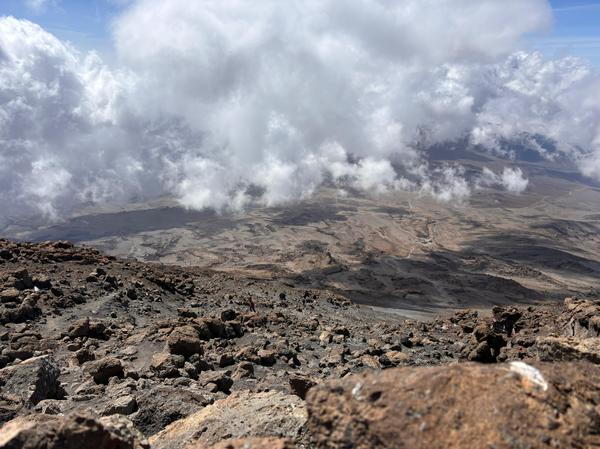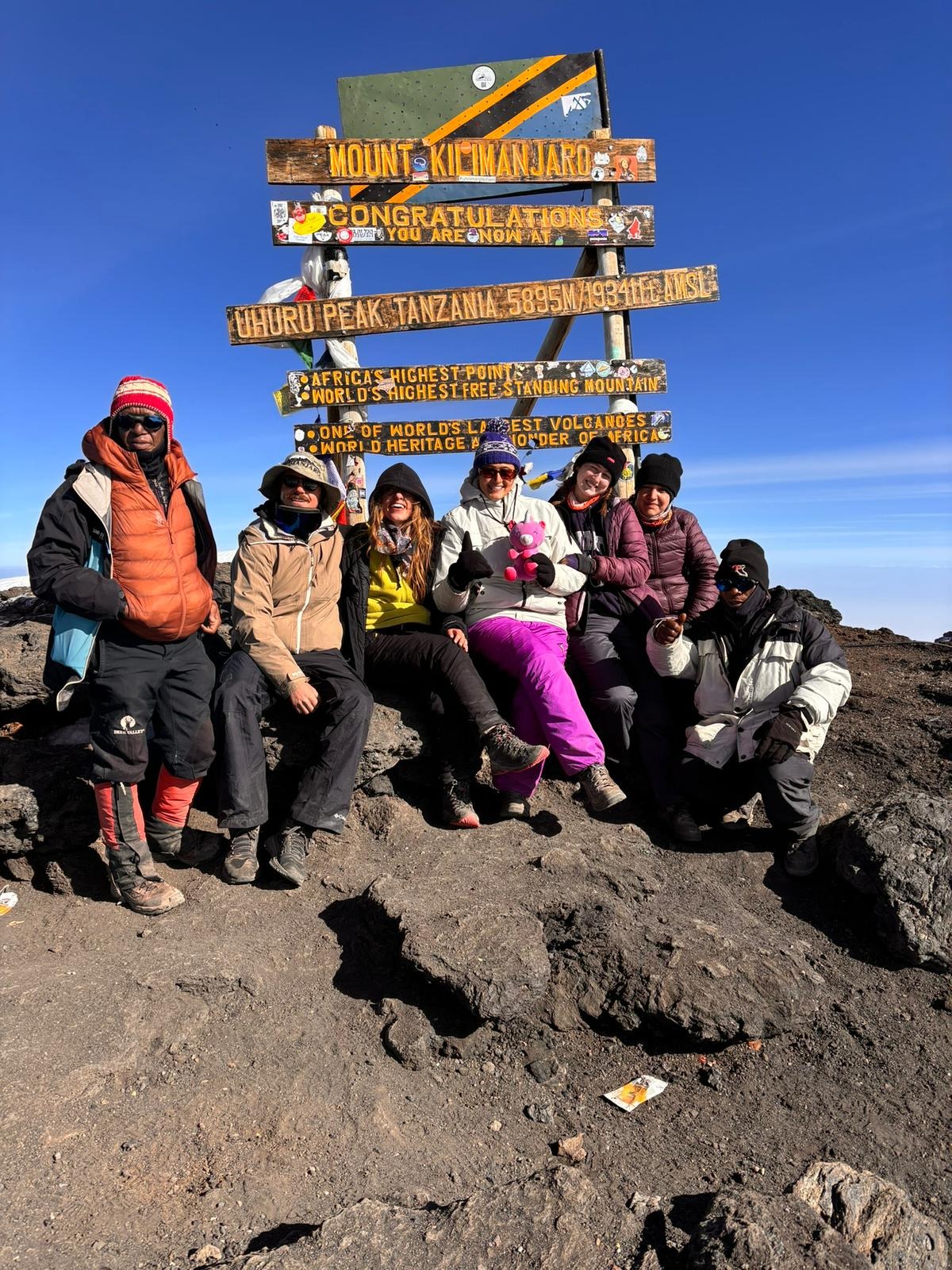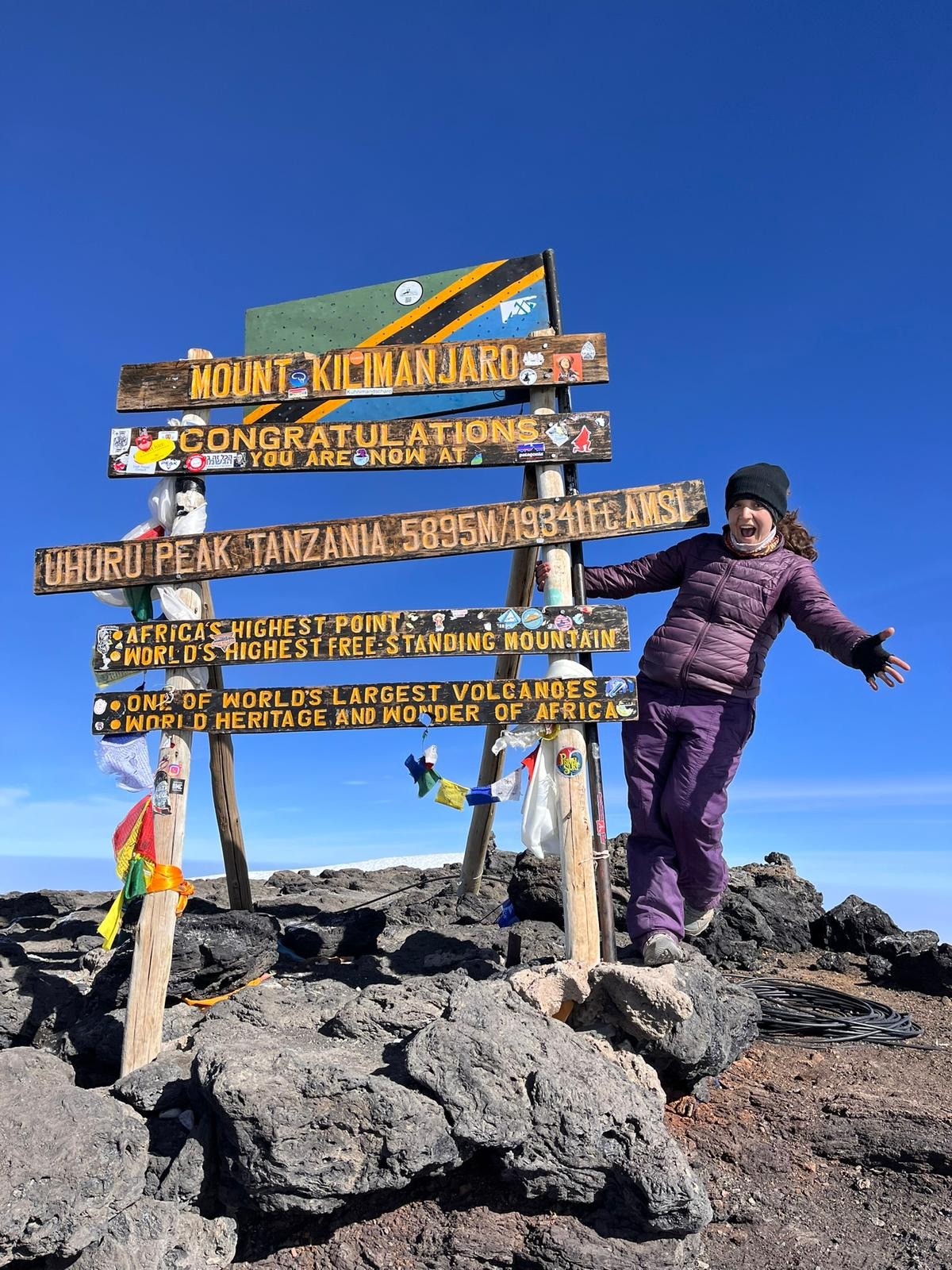

3:00 a.m
“Hapanaaaaaaaaaaa*!” I screamed, my voice cutting through the empty deep darkness which wraps around Mount Kilimanjaro. Suddenly, my heart was pounding like a sharp rock hitting the ocean, I was scrambling to catch my right leg as it melted into the soft rock and skid off the zig zag footpath. “No, no, no, no, no!!” I wimped like a child as my fingernails clawed into the volcanic rock. Is this the fucking end? The loose rock made an avalanche of pebbles below my path, catching the attention of the hikers behind me. Arnold, our guide, burst from behind the pack and jumped to my rescue. He clenched his hand around my frail arm and steadied me before my noodle legs would let loose, and I would slip again. Down below was a drop that felt like hundreds of thousands of metres and I was about five seconds away from tumbling down. There was no rail or net to catch me, just the pitch black dark. They say the summit begins at 12:00am so the hiker can reach the peak by sunrise, but the alternate truth is this: hiking in the dark conceals the insanity of the vertical fortress we set to climb.
The world around me felt black as coal. Suddenly, I was a seven-year-old Pammy scared in the dark. After five days of walking blissfully through rainforest, desert, and misty clouds (Cerveny & Cerveny, 2020), I was now in the thick of the real Mount Kili test — summit day. The hike began just after midnight, and although we were high above the clouds, I didn’t feel the freedom or lightness you’d expect. Instead, there was a boulder sitting on my chest dragging each breath down — it was part altitude sickness, part confusion. Anger engulfed me because I had no real reason for the hike and I had just rubbed shoulders with death. Hannah from England did, her grandmother recently died, and she was carrying close to her chest a picture of “her and nan” because “nan would be so proud of me,” she exclaimed in her thick English accent that sounded funny to me. Nan was dead and Hannah was sad. But no one had died for me, I thought selfishlessly. And the question suddenly came crashing down in the pitch dark, on why the fuck I was summiting this mountain, Pamela?
I readjusted my backpack and continued to put one foot in front of the other like a soldier. Arnie, the affectionate name we gifted him during our expedition, looked at me dead in the eye, “Pole pole*” he said, and I hovered behind slowly like a turtle. My legs were unreliable, my finger tips were frozen by the gusts of icy winds and -10 degrees temperature (Cerveny & Cerveny, 2020) and for the first time in years, I organically recited in my mind Lord, give me strength. With every stride it grew louder eventually reaching the tip of my lips. And so I asked the Lord to give me strength, but I also found myself proclaiming it for all the girls — Lord give Ambra strength, Lord give Hannah strength, Lord give Nicole strength because we were all uncharacteristically silent.
I knew Nicole from university, but Ambra and Hannah were two amicable girls from England whom we met in the Arusha volunteer house called ‘Simba’. Ambra and Hannah were volunteering in a childcare facility, while Nicole and I taught English at a primary school to young children. We got along superbly — no tension or awkwardness — just four happy-go-lucky girls hiking a mammoth mountain. Together we made it to each checkpoint hut by filling the hours with random story times, and obnoxiously loud karaoke sessions as we trekked through the rainforest and desert. There was arguably too much singing, and a chaotic rotation of every music genre from ABBA to Bob Marely, blasting through a dingy ten-year-old JBL speaker for five straight days. Even our guides, Arnold and Richard, occasionally joined in, while the porters* — who somehow breezed past us carrying our 10kg hiking packs (Peaty, 2014) — laughed at these mzungus* belting out tunes mid-hike
My fear which loomed like a dark cloud over me slowly began to trickle away with the comfort that Arnold would save me if I were to spontaneously slip again. Arnold would repeatedly turn around, checking up on me, and offer to take my backpack but I sternly refused each and every time. “No! I’m fine.” I would snap, in an edgy tone. He was only trying to help me, and now I can’t help to think how much of a bitch I was to this kind Swahili man. At one point he tried to grab my bag and I pushed his hand away like a toddler. My defiance to any type of help would become one of the many jokes of the trip. Everyone had given their packs to the guides at one point but I just couldn’t. It wasn’t like I was holding a diamond ring in there. Rather I began to cling onto the words of my father. I could hear his voice echoing in my mind of the questions and comments he would ask me after the summit, “Did you carry the pack up?” “You need to wear your own pack when you’re climbing the mountain.”
I will do it, I will carry my own pack up this mountain myself, I thought. I’ve always been stubborn, so it’s no surprise I put the pressure on myself to keep carrying my hiking backpack, when I was clearly struggling.


4:00 a.m
The answer started to ring in my ears. My mother held the unwavering belief that I could do anything, and that somehow, simply by being her child, I was bestowed with the chance to experience great things. Her years of guidance, love and faith felt real as I was hiking a slope so steep my foot rested at a ninety-degree angle at each step.
Here I was — twenty years old, fit and healthy — doing the great thing my mother always said I would. I looked ahead of us where many groups of climbers moved just as slowly, and their headlamps glowed forming a winding constellation of faint lights. I squinted my eyes to make out the furthest light. It looked like a tiny glow worm in a tunnel… Fuck me, I thought. There’s still so far to go. I knew that if I wanted to reach the summit in time for sunrise - to see that promising, soul-piercing light I couldn’t turn back. The end would be hard, but 50% oxygen (Davies et al., 2009) of what I am used to in flatter than a pancake Sydney, Australia - made every breath harder than the next. There was nothing profound about walking in temperatures plunging lower than -0°C (Cerveny & Cerveny, 2020) either. I wore double thermals, a shirt, a jumper, a puffer and then a huge purple snow jacket on top with matching purple snow pants. But still, it was not enough. Under all these layers there was a bone-chill which even pocket heat handwarmers couldn’t fix. The howling gusts of wind as I stood at 5,000m (Moore, 2003) above sea level slid into every crevice of my clothes, and even now when I sit in a large gust of wind, I suddenly feel like Mount Kilimanjaro is nearby.
I turned around to find Nicole trailing at the end of the single-file line, shaking. I remember when José returned from her summit and told Nicole and me on Simba house's communal couches, “Eet eez so beautiful. I theenk you are going to lof eet.” Her Chilean charm had made the climb sound romantic, life-changing, unmissable. She was clearly good at euphemisms. We had come to Africa to volunteer, not to summit a mountain, I’d told her. And yet Nicole and I had spontaneously committed to climbing the world’s tallest free-standing mountain — Africa’s highest peak — because it was right there (Moore, 2003). And when would that ever happen again? It was Nicole who really sold me on this hike. If she hadn’t been on this volunteering trip with me, I never would have done it. So when I saw her struggling up the mountain, I started to spiral with worries.
I clawed into every ounce of who I am. Both sets of my grandparents — my γιαγια* and παππου* — came here for a better life. They left their poor villages, which were ironically up in the mountains, to establish something.
Is this the something they imagine their sacrifice would look like? I thought.
Then suddenly I bombarded myself with questions.
My grandmother left a village, to provide me the opportunity to summit a mountain above the clouds? They came to Australia and worked long hours in the factories to generate all this wealth, for who? Their children, their grandchildren - for the generations ahead. For me. And here I am, reaping the benefits — spending thousands of dollars on the other side of the world to experience this great thing my mother always said I would.
I looked down at myself. All I saw was dust and darkness and all I felt like was a giant purple marshmallow trekking in the dark. And that god forsaken wind was howling in my eardrums like an unpleasant tune. If there is one thing I can do, I thought is to not wimp in my pain but to honour this pain for them. To feel, just momentarily, the struggles they faced of starting a whole new life with nothing but a suitcase in their hand. On this mountain, here, I was feeling one mincuscule of the sacrifice they made for me.

6:00am
We missed our sunrise summit but we did not care. “Get me to the top of that fucking mountain,” Ambra said to me, breathless and unsmiling. We had already passed Gilman's point and Stella’s point (Moore, 2003). Here’s the thing — I learnt about all these check points on the summit as we hiked along. In fact, Nicole and I didn’t even know Mount Kilimanjaro existed before we landed in Tanzania. I remember flying into the mainland on a tiny propeller plane when the pilot made an announcement, telling us to look out for Mount Kilimanjaro. Naturally, I looked down, searching for a mountain below. Nothing. Then I looked straight ahead, at eye level, and there it was. Our jaws dropped and I could not believe Uhuru peak floated above the clouds at the same altitude we were flying.
Even at base camp, Kibo Hut, which stood at 4,720m (Moore, 2003) I remember the stretch of my neck as I craned it back to spot the summit and that famous, Congratulations, You are now at Uhuru Peak Tanzania sign Arnie told us about. But I couldn’t see it.
Before we reached base camp we walked along a stretch of desert rocks, pushing fiercely against the wind. We were our usual selves, cheekily singing and playing around with our guides. As we hiked the steep slope toward the final hut, we began passing people descending the mountain. They seemed exhausted and tired, but elated. Then we see two porters carrying a stretcher. Was someone hurt? I thought? As we drew closer to each other it became clear this person wasn’t hurt, they were dead. Wrapped up in a blue sleeping bag like a makeshift body bag being stretched down. Arnie told us they were “sleeping”, but I don’t think a sleeping bag fully enclosed would be appropriate for someone who is alive. This was the first of the what the fuck am I doing moments. I couldn't have anticipated how many times I'd say or feel it on the summit that awaited me.
Now, this crazy long journey was about to finish. The roof of Africa was around the corner, and I felt like I had experienced a lifetime in a few days.
9:00am
I started watering the mountain with my tears and my brain felt like it was pressing against my skull. “My head hurts,” I told Arnold. I was suffering from high-altitude cerebral edema (Cleveland Clinic, 2023).
My knees were cold — I had jumped into the snow on Kilimanjaro’s glaciers because it was the first time I’d ever seen snow, and all I’d ever dreamed of as a kid was launching myself into it and making a snow angel like they did in Disney cartoons.
I was crying too. Arnold told me it was the lack of oxygen, but I was crying because I knew exactly why the fuck I did this.
I had stood at 5,895 meters, on top of Africa (Moore, 2003) —for my mum, my dad, and my grandparents.

My travel memoir, The Story of the Summit, immerses audiences into the feelings and reflections I experienced upon my nine hour journey summitting Mount Kilimanjaro in Tanzania, Africa. The memoir traces my stream of consciousness through four key moments — 3:00 a.m., 4:00 a.m., 6:00 a.m., and 9:00 a.m. — drawing inspiration from Tara June Winch’s First, Second, Third, Fourth (2018). Akin to Winch, I employ a formulaic structure to build promise for the reader and structurally unfold the moral of my story. That is, in moments of fear, one must confront their purpose. Regarding my ethical considerations, I decided to keep the term ‘mzungu’ which means ‘white person’ in Swahili. At the time of hiking Mount Kilimanjaro, I had been in Tanzania for five weeks. A local teacher at the school where I volunteered explained being called a mzungu carried no negative connotation, so I decided to retain it in the memoir to preserve the authenticity of my story, as it accurately reflected how the local people perceived us. The drafting and re-drafting process spanned over numerous weeks. I knew immediately I wanted to express the gratitude I felt for my familial sacrifices which ultimately granted me the opportunity to stand atop the highest free-standing mountain in the world (Moore, 2003), but it took reaching out to my friend Ambra in England, and diving back into old videos and memories to remember it was actually the panic of my fall which caused me to spiral. My research included reading other journals which unpacked hiking Mount Kilimanjaro and interviewing my mother and Nicole. Overall, I feel deeply connected to this story, as it reflects on one of the most turbulent times in my life and captures an eight-hour journey I will carry with me forever.
Australian Government Geoscience Australia. (2014, June 27). Elevations. https://www.ga.gov.au/scientific-topics/national-location-information/landforms/elevations
Cerveny & Cerveny. (2020). The Snows of Kilimanjaro: A Climate Journey From Rainforests to Summit. Weatherwise (73) 5, 42-59. https://doi.org/10.1080/00431672.2020.1787744
Chrysoula Rontziokos (Personal Communication, October 15, 2025).
Cleveland Clinic. (2023, August 23). Altitude Sickness. https://my.clevelandclinic.org/health/diseases/15111-altitude-sickness
Cleveland Clinic. (2023, April 10). HACE (High-Altitude Cerebral Edema). https://my.clevelandclinic.org/health/diseases/high-altitude-cerebral-edema-hace
Davies, A., Kalson., S & Stokes., S. (2009) Determinants of Summiting Success and Acute Mountain Sickness on Mt Kilimanjaro (5895 m). Wilderness and Environmental Medicine 20 (4), 311-317. https://doi.org//10.1580/1080-6032-020.004.0311
Moore, Tim. (2003, February 17). Kilimanjaro? Well, it nearly killed me. The Guardian. https://www.theguardian.com/travel/2003/feb/16/tanzania.climbingholidays.observerescapesection
Nicole Stellios (Personal Communication, October 25, 2025).
Peaty, D (2014). Kilimanjaro Tourism and What it Means for Local Porters and for the Local Environment. Journal of Ritsumeikan Social Sciences and Humanities (4)1, 1-11.
Robinson, B. & Edwards, M. (2004). Climbing Mount Kilimanjaro in a blizzard. Medical journal of Australia 181 (11-12), 646-648. https://doi.org/ 10.5694/j.1326-5377.2004.tb06504

